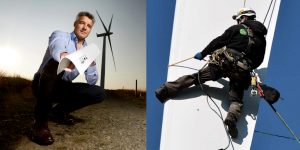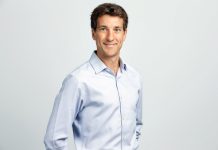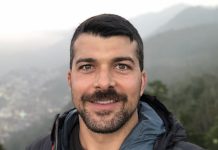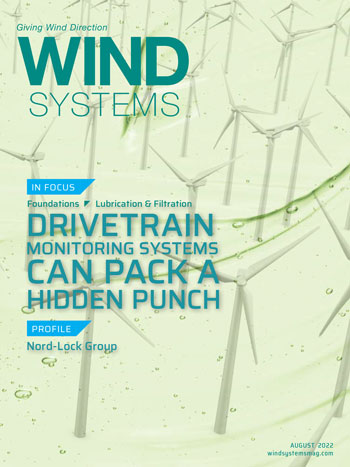Rope Partner recently partnered with Edge Solutions. How did that partnership come about?
Urch: We were looking for partners in the U.S. a couple of years ago. We had some initial conversations with Eric Stanfield, CEO at Rope Partner. They were really constructive, and he had some insightful comments around our product, which we respected and actually implemented during some trials we were concurrently running in Europe COVID was kind of an interruption to us coming to the U.S. to meet with Eric, Lucas, and the team. But as soon as we were able to, we got on a plane and came out to a conference in Austin, Texas, where we had a chance to meet in person. I think there, we really kind of hit it off, and we were able to cement those early conversations. We were able to get across the design enhancements we’d made and instill some confidence that we had a lot of momentum and traction with sales in Europe and that this could be a product that Rope Partner could introduce successfully to its customer base in the U.S.
We really like Rope Partner. They’re a leading company in their field. They have very high attention to detail, to quality, and training. These are all things that resonate with us, and they have fantastic contacts at the Tier-1 customer level. They offered us everything we wanted to accelerate our expansion into the U.S. market.
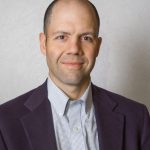 Llado: It makes sense to us as one more valuable product in our toolbox. With different technologies coming out for leading edge protection, the Armour Edge solution is performing well and can offer unique value to our clients. There is a big opportunity here in the U.S. wind market , so we wanted to partner up with Armour Edge and help bring this product to market.
Llado: It makes sense to us as one more valuable product in our toolbox. With different technologies coming out for leading edge protection, the Armour Edge solution is performing well and can offer unique value to our clients. There is a big opportunity here in the U.S. wind market , so we wanted to partner up with Armour Edge and help bring this product to market.
What is Armour Edge, and what can it do for the life of turbine blades?
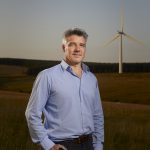 Urch: Armour Edge is a hard-shell, leading-edge protection product for wind-turbine blades. It’s going to protect your turbine blades from erosion resulting from rain or crop dust or sand. This erosion affects the aerodynamics, and, therefore, the power output and can eventually lead to blade failure if not treated.
Urch: Armour Edge is a hard-shell, leading-edge protection product for wind-turbine blades. It’s going to protect your turbine blades from erosion resulting from rain or crop dust or sand. This erosion affects the aerodynamics, and, therefore, the power output and can eventually lead to blade failure if not treated.
Our founder came up with a novel approach to this issue of leading-edge erosion and created Armour Edge. It’s unique because we make Armour Edge to fit each particular blade type. It’s a custom solution. It’s unique because it’s incredibly durable.
We had a lifetime prediction report from an independent laboratory giving us a 53-year lifetime estimate. Also, we believe it’s unique because it has very beneficial aerodynamic properties. If you’re saving even half the 1 percent of annual energy production on a wind farm over 20 years, that’s a huge amount of money.
A version of this length is being fitted on an offshore wind farm right now in Germany. This material is designed specifically to go on wind turbines.
We also have our own custom adhesive that is also part of the solution. The adhesive has a very strong bond, as you would expect, but it also maintains very good elongation or flexibility, so it can work in that dynamic environment. Because we are essentially recreating the leading edge of the blade with that hard surface, it results in excellent aerodynamic performance. Various reports show that we have less than half a percent of impact on the annual energy production. If you think an average level of erosion on a blade might cause 1 to 5 percent of AEP loss, and if we give around half a percent of loss compared to a virgin blade, that’s a big uplift.
I think one of the key aspects about Armour Edge is, and why I think Rope Partner finds it so appealing, is because we can install Armour Edge really efficiently. There’s no extra downtime compared to other solutions. In fact, we’re almost quicker than other solutions and more cost effective. When you look at blade erosion, we categorize it in different ways.
If it’s quite minimal erosion, it might be category one; if it’s really high and severe erosion, it might be category five. For category one to three erosion, we can apply Armour Edge directly on top of that erosion without doing any significant blade preparation or repair.
That’s a really big saving in terms of turbine downtime and in terms of labor. We can also apply Armour Edge on top of failing leading-edge protection. If you had some tape, for example, that failed after a certain amount of time, you would normally have to stop your turbines and have this cycle of repeated intervention (remove old tape, apply new tape) — that’s costly. You put new tape on, then come back in a few years. We can actually apply Armour Edge straight on top of that tape without stripping it and without repairing the blade, so you’re saving time, and then you’re getting a solution that should last the remaining life of the wind farm.
We might not extend overall life of the turbine, but we’re going to make the economics of running it much more attractive during its life.
And when you go offshore, which is our current experience in Europe, if you can save person hours offshore, that’s a massive health and safety benefit, as well as a cost benefit.
What is Rope Partner’s role in incorporating the Armour Edge technology into the existing wind farms?
Llado: It’s twofold. On the commercial side, we are the point of the spear in connecting with our extended U.S. customer base, which we have successfully built over our 21-year history. Then on the actual installation side, we’re the exclusive third-party installers of the product in the U.S. It’s how we’ve set up the agreement. We are performing pilot installs with customers this year and will then move to a larger scale roll-out both onshore and offshore.
Urch: I think also one of the big facilitation aspects that Rope Partner brings is their new location in Denver, which offers a state-of-the-art space for trainings. That’s going to be the focal point for all our training in the U.S. It is imperative that all technicians are trained to a high standard, so we get a very good level of installation.
Llado: The benefit of having our facility centrally located, not only for just storage of the product when necessary, but also, of course, as David indicated, the training is a good arrangement for our partnership.
Is Armour Edge only used for offshore turbines or can it help extend the life of all turbines?
Urch: It can work on all turbines. And it just so happens that we have had our first customers all in the offshore environment. But, of course, all turbines experience some kind of erosion. Definitely the onshore market is a huge opportunity for us as well.
Llado: It’s applicable to any turbine. The offshore turbines just typically have the highest erosion environment, which is the extreme of this spectrum. But then, of course, this product is also very beneficial for onshore application. There’s a lot of leading-edge protection being applied on onshore turbines globally and the product makes sense for both markets, offshore and onshore.
What has been the response from wind-farm owner-operators in the Baltic and North Seas that are using this new technology on their assets?
Urch: I think the initial response is positive in that they’ve ordered more. For me, that’s the biggest validation of the product. Your first customers take your product; they put it in the harshest environment, and they come back to you a year or two years later, and say, “You know what? This stuff’s good. We’d like more.” For me, that’s the overwhelming thing.
In terms of the detail, it’s also not just that the owner-operator likes it, it’s that the technicians who installed it like it. They like working with it.
It’s an easy-to-install product. It’s intuitive, and you get a good job of it. That’s really good.
How long has Armour Edge been available?
Urch: The first product went on in summer 2020, so we’ve been installed for two years now.
How will Armour Edge be useful in the U.S. offshore market?
Urch: I think because the U.S. offshore market’s nascent, there is an opportunity down the line so that we could retrofit, in say five-years’ time or three-years’ time when those wind farms are coming off warranty and getting erosion problems. That would be the kind of classic way that we’ve approached the market in Europe.
But what is happening more and more, and particularly here in Scotland where there’s a lot of offshore wind being developed, is that developers are under massive pressure to demonstrate in their business plans that they’re going to address leading edge erosion up front.
If we can say to these guys, “Look, if you actually design us in from the outset and you fit us before the blades go into service, you’re going to save a lot in terms of annual energy production because we’re preventing the erosion and thus assisting the aerodynamic benefits.
But also: How much are we going to save you in terms of repeated intervention to put an LEP on every three to seven years? How much are we going to save you in terms of worker risk offshore, and how do you score that in your matrix for the whole project?” Those are the really interesting discussions that we’re starting to get into now.
We haven’t gotten factory fitted yet on a turbine, but I think that’s the next logical step for us. And I think that’s another way we could make a really big impact on the U.S. offshore market now, rather than in three to five years’ time, when the erosion’s already happening.
It would seem to be advantageous to install Armour Edge at the beginning of service, correct?
Urch: Definitely. We’re really looking hard at that right now, and obviously Rope Partner can be our partner for facilitating that in the U.S. as well. Some of the operators offshore in the U.S. are the same as in the U.K. or Europe. There’s a real nice synergy there and a crossover. I think we can make a really big impact in offshore U.S. wind.
What inroads have been made in making sure the U.S. offshore market is aware of this product and its positive impact to wind-farm assets?
Urch: From our side, this is kind of early days for that. We’re focused really on getting reference sites onshore in the U.S. because I think everybody’s kind of like, “I see you doing that in Europe, but I want to see it in my backyard to know I can really touch it, feel it, see it, and get comfortable with it.” That’s our prime focus right now. But as I said at the Blades USA conference in Austin, we’re already connecting with people who are building offshore.
Llado: That’s more of a mid-term strategy, as all these new projects come online in the next five years. We have several years of offshore experience and are well positioned to grow with this market.
Urch: I think you’ll see a big step up in our marketing activity in the next six months or so. As we evolve as a business, that’ll be another major focus for us going forward. That should all help with awareness.
Is there anything else you would like to add that we didn’t talk about?
Llado: We’re very excited about this partnership. While we continue installing various LEP products in the market, we believe that Armour Edge brings an innovative and valuable solution to the U.S. wind industry, and we are happy to be presenting this product to our customers.
More info www.RopePartner.com | armouredge.com
















